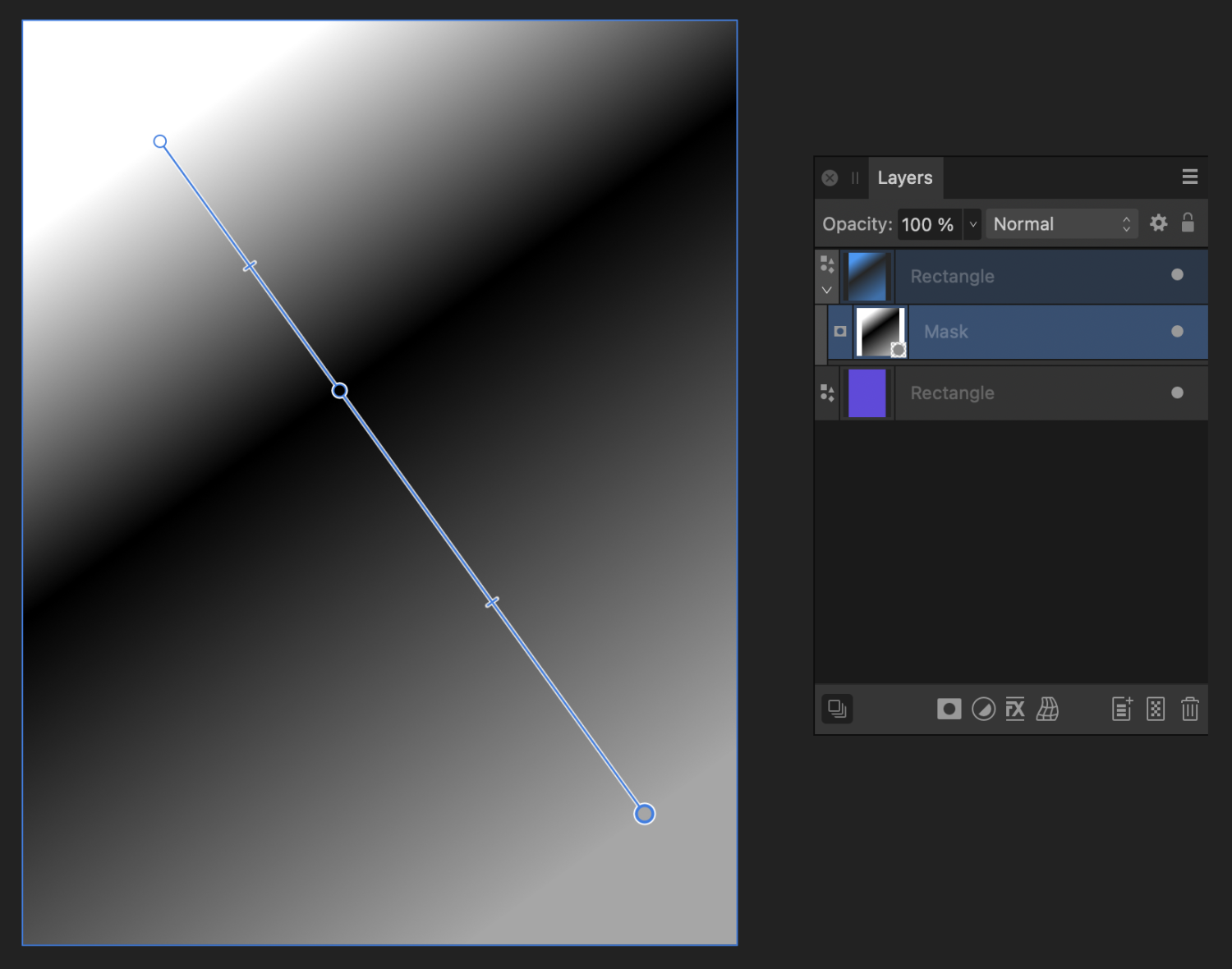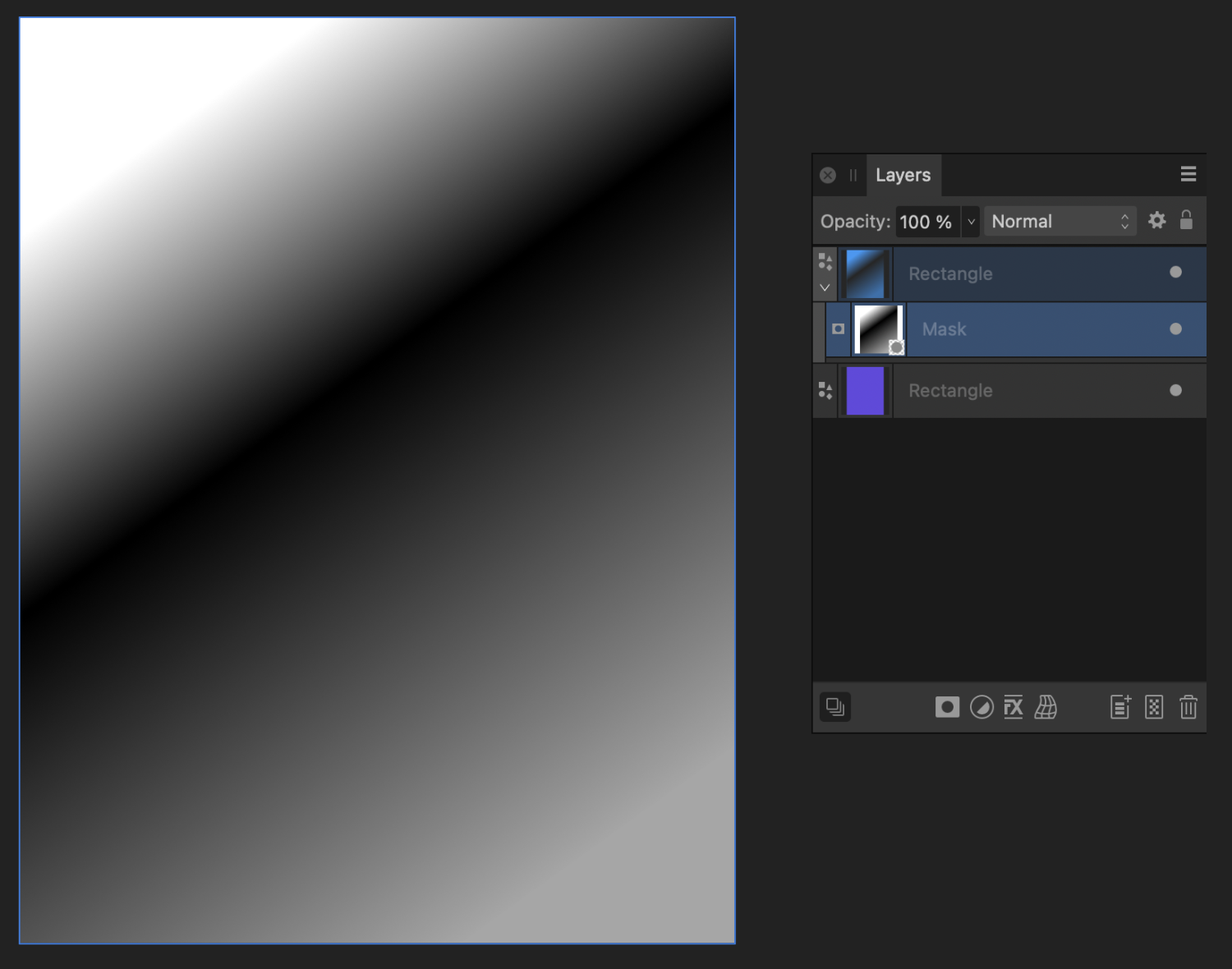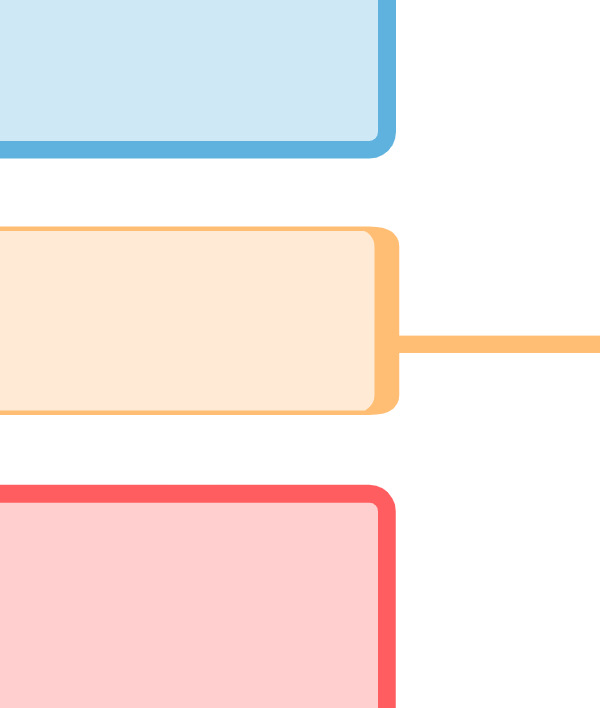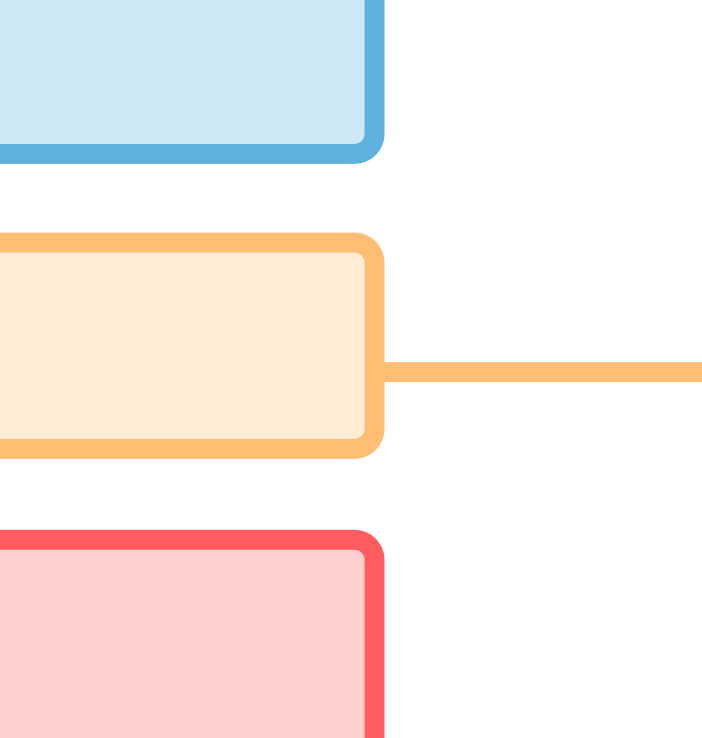-
Posts
27 -
Joined
-
Last visited
Everything posted by Davide.Barranca
-
Hi all, I'm drawing a gradient as a mask for a vector layer: All is good, except that, subsequently, I don't seem able to edit the gradient anymore: When I try to edit the existing gradient in the Mask (which I'm assuming is editable, but I might be wrong), as soon as I click anywhere with the gradient tool, Designer gets me back to the composite visualization: I'd have expected the same behaviour with gradient fills. Is this as expected? Thanks, Davide
-

SVG Export bugs: distorted corners' stroke, text
Davide.Barranca replied to Davide.Barranca's topic in V1 Bugs found on macOS
Sure, here is the exported SVG and the source .afdesigner. I ended up doing the SVG by hand with code, it's way (way) cleaner – a bit of a PITA, but more readable. Quite unclear why all those unnecessary <tspan>s and rect turned into paths: I suppose it makes sense for complex designs but a handful of basic shapes with with fills could be handed more easily. ¯\_(ツ)_/¯ RoundedCorners.zip -
If you export to SVG a rounded corners rectangle with a stroke it gets heavily distorted/stretched depending on the rectangle's ratio. This is Designer (as it should appear): This is the result of the SVG exportation – setting: SVG (for Export) – loaded in a browser The fill makes no difference (I've tried with and without) Also Text is kinda funny: is this normal? <g id="Adtion-text" transform="matrix(0.354872,0,0,0.976774,-577.26,976.881)"> <text x="1659.04px" y="248.288px" style="font-family:'SourceSansPro-Bold', 'Source Sans Pro', sans-serif;font-weight:700;font-size:52px;">Action Butt<tspan x="1916.9px " y="248.288px ">o</tspan>ns</text> <text x="1659.04px" y="308.288px" style="font-family:'SourceSansPro-Regular', 'Source Sans Pro', sans-serif;font-size:40px;">Apply the e<tspan x="1844.96px 1867.52px " y="308.288px 308.288px ">ffe</tspan>ct<tspan x="1919.8px " y="308.288px ">,</tspan> Canc<tspan x="2020.28px " y="308.288px ">e</tspan>l</text> <text x="1659.04px" y="360.288px" style="font-family:'SourceSansPro-Regular', 'Source Sans Pro', sans-serif;font-size:40px;">or ac<tspan x="1740.6px 1758.04px " y="360.288px 360.288px ">ce</tspan>ss Document<tspan x="1993.64px " y="360.288px ">a</tspan>tion,</text> <text x="1659.04px" y="412.288px" style="font-family:'SourceSansPro-Regular', 'Source Sans Pro', sans-serif;font-size:40px;">Support and Pr<tspan x="1912.68px 1932.4px 1943.68px 1963.64px 1977.12px " y="412.288px 412.288px 412.288px 412.288px 412.288px ">efere</tspan>nc<tspan x="2036.4px " y="412.288px ">e</tspan>s</text> </g> Please note how the four lines get split into a myriad of useless "tspan" tags (I had to remove them all manually) Designer 1.8.4 on macOS 10.15.7
-
I've replied privately to stingOM, but I'd like to post here as well FYI. The product we're talking about is made of a scriptable C++ plugin that relies on a CEP Panel for the GUI/internal logic, hence it is not portable to the Affinity ecosystem (yet, at least). As I've made clear elsewhere, many PS developers are eager to build products for Affinity, as soon as the technology will be ready. To date, it's not clear which shape or form it's going to have. Best regards Davide Barranca cc-extensions.com davidebarranca.com
-
Sure enough, it'd be nice to have an environment/API that would allow such third-party plugins. I can't wait! I do acknowledge that it isn't the first feat. request that may cheer the average user, but this doesn't mean one shouldn't log a request anyway :-) As for the user segmentation, as a technical author I am evaluating myself whether to go with Affinity or stick to the MarkDown -> LaTeX -> PDF workflow (either Pandoc, LeanPub or SoftCover). Both choices have their pros and cons... Davide
-
Hi, technical authors – myself included – may need to design books that include programming code (C++, JavaScript, Python, you name it) with proper syntax highlighting. As discussed at length in this thread, copy & paste from the code editor (e.g. Visual Studio Code, Sublime Text, Atom, etc.) to a Text Frame doesn't work. Besides, it seems that Edit > Paste Special is a Win only feature of Publisher. The one workaround available involves an intermediate step: Copy from the code editor. Paste to an application such as Word, Apple Pages, LibreOffice. Copy from Word/Pages/etc. and paste to Publisher text frame. This way, as far as I get, the proper Rich Text information is preserved. Although the process works, the extra step is not only tedious, but doesn't scale up when the book contains a good deal of code samples that must be maintained in an easier, faster fashion. It would be much handier to have the option to either select a portion of text in a Text Frame and assign the Language (programming language) that automatically triggers the appropriate syntax highlighting. Or have a Code Text Frame as a separate tool altogether, with properties, options and such. Thank you! Davide Barranca
-
Very weird indeed! I would have expected a 1:1 match between platforms. I've not used Word or LibreOffice as a bridge but Apple Pages (so it's VSCode -> Pages -> APub), and it seems to work. As I wrote, even if I do some InDesign stuff I'm not experienced enough to know how page design applications deal with code syntax highlighting, hence the question about the opportunity of a feat. request. Thanks!
-
Hi, I have similar needs (code syntax highlighting) and I've found that copying from Visual Studio Code and pasting directly into a Text frame doesn't retain the metadata. An intermediate step pasting to Text Editor doesn't help either. Instead, pasting to Pages, copying from it and eventually pasting to Affinity seems to work – almost, for to apply the specific font glyphs (I use Fira Code, which has super fancy substitutions for stuff like ===, !=, =>, etc.) it's better to re-apply a Style. All in all, it is quite a cumbersome process; frankly I don't know how other page design applications deal with that need – so far I've been using either Leanpub or Softcover, that get markdown in and output pdf with an intermediate LaTeX step – syntax highlighting come as a built-in feature, and it is language-specific (JavaScript has a different highlighting from C, etc) Would that be a sensible feature request? Technical publishing isn't a small niche I suppose :-) Thank you, Davide Barranca
-

Photoshop Apply Image Functionality Needed
Davide.Barranca replied to JimGoshorn's topic in Older Feedback & Suggestion Posts
FYI, I've added some extra comments and feat. requests related (mainly, but not exclusively) to the Color Correction / Prepress business here: https://forum.affinity.serif.com/index.php?/topic/25530-color-correction-prepress-missing-tools/ Besides automation and Apply Image, the 10 channels palette would be a game changer IMHO. Thank you –Davide -
Hi, on a regular basis I check Affinity Photo to asses how close it has become to a viable alternative for Color Correction / Prepress production jobs. People in this business (including friends and colleagues of mine, worldwide) tend to use an established set of techniques, which in turn require tools – not many, to tell the truth: we could be using Photoshop CS4 and do 99% of what's needed to get the job done. FYI, what would make legions to operators switch to AP (but AP still misses) in my opinion are: 1. A proper set of Channel Blending tools, namely: Apply Image working on the open image's own channels: e.g. apply the Red to the Green, Lighten mode, 50% opacity. We use Channel Blending on ~80% of all images we work on. Calculations is handy too, but Apply Image would be OK. 2. A proper automation system: Macros are the first step, scripting is the second (I know there already are topics on this so I'll just mention it). Production doesn't only mean batch processing, but also dedicated script that can automate hundreds of steps based on each image's features. The two above are, I would say, mandatory for people in my business. Which includes also savvy retouchers. A delightful extra, instead, as follows. The AP team already gifted us with a true gem: Curves in RGB, Lab and CMYK – at the same time. What would obviously follow (at least for a color correction twisted mind) is a Channel Palette displaying at the same time R, G, B, C, M, Y, K, L, a, b, 10 channels. This, combined with Apply Image working on channels would make us drool and set on fire existing subscriptions. I'm sure the engineering team has its own, well defined, priorities: my intention is to put to your attention what are the needs of some professionals in the imaging business. Thanks for your attention and best regards, Davide Barranca
-

Photoshop Apply Image Functionality Needed
Davide.Barranca replied to JimGoshorn's topic in Older Feedback & Suggestion Posts
I'm afraid the missing Channel Blending feature (Apply/Calculations among channels of the same image, not involving saving duplicate copies) is a sad show stopper for anybody who does Color Correction and Prepress. It's such a crucial and established technique that not being able to use it (or requiring so many time consuming extra steps, which is equal to: not being able to use it in production) is a wall I can't work around, alas. -
As a Photoshop panels/script developer myself, I'm *eager* to see Affinity showing interest into this kind of extensibility. Latest OSX and latest PS combined have proved to be a pain in the neck in some production environments (talked about that very recently with a colleague of mine who is consulting for a large printing company), and we start hearing some feedbacks about the speed and performances of Affinity Photo. Alas, unless at least some basic scriptability isn't in the features set, we're out of luck. Back in the pre-release days, I know that scripting has been discussed (and still wasn't top priority) - it would be nice to know from somebody in Affinity whether it's possible to expect that coming in the next couple of major versions or not at all. It would be a crucial bit of information for professionals who are taking into consideration a switch in the mid or long term, at least on some production environments. (clearly it's too early to discuss *what* kind of extensibility - language, features, etc - even if I'd personally vote for JS) Thank you in advance! Davide Barranca
- 29 replies
-
- AppleScript
- Affinity Designer
-
(and 1 more)
Tagged with:
-
Hi, there's a Plugin for PS (Windows only) called Curvemeister which allows to Curve in different colorspaces. E.g. the document is RGB, the Curves dialog shows the usual RGB Composite + R, G, B channels and L, a, b, and C, M, Y, K (which channels are calculated on the fly). In PrePress it's quite usual to switch carelessly from one colorspace to another to exploit each colorspace peculiar features. The multi-colorspace Curving could be implemented, say, only when the document is converted to Lab (so that you're already in a device-independend space, which saves you a conversion). Thank you, Davide Barranca
-
Hi, as far as I can get (unless I miss something) there's still room for new features in the Apply Image area, which in PrePress is paramount (second only to Curves). For instance Apply Image: channel on channel (example: one document open, apply the Red channel from layer A on Green channel, Soft Light, 50% opacity). It would be astonishing if you could borrow channels from on-the-fly conversion to a different colorspace. E.g. a RGB document: Apply the "a" channel from Lab to the Composite, Overlay (being the a of Lab calculated without the need of duplicating the document). Besides, Calculations in PrePress is often very useful too (New Alpha channel which is the result of, say, Difference of Green and Blue). Thank you, Davide Barranca










